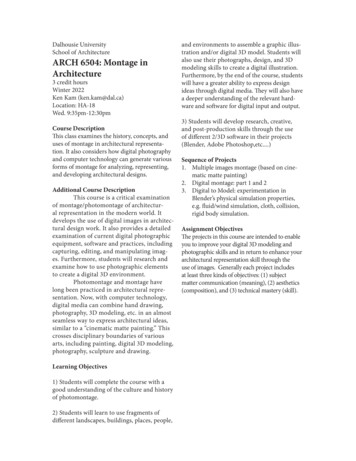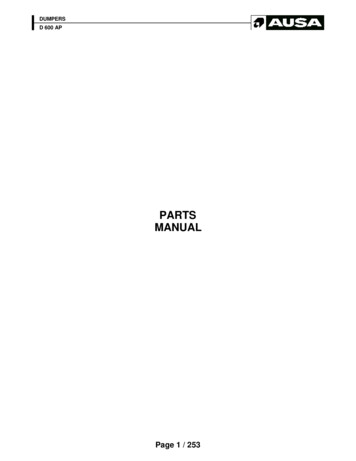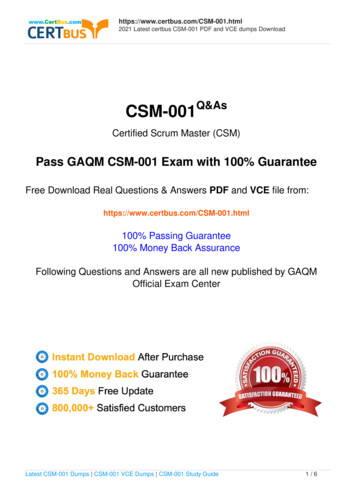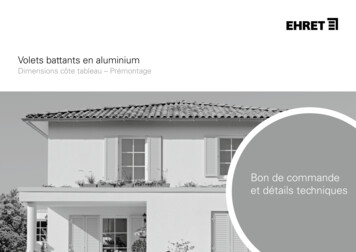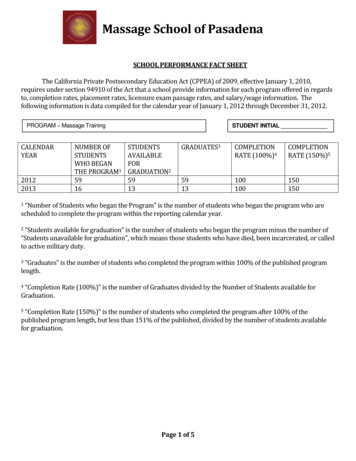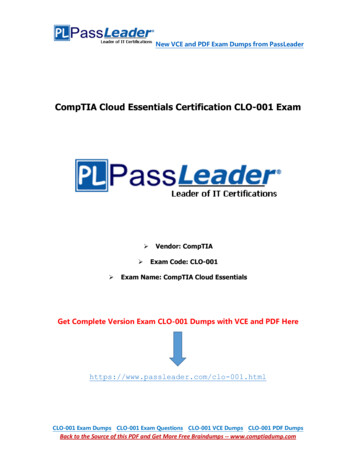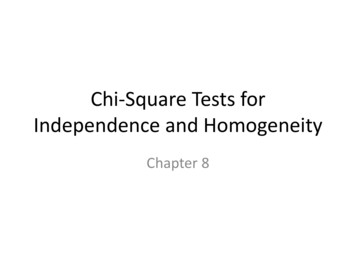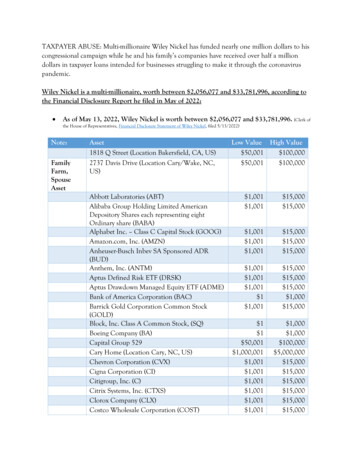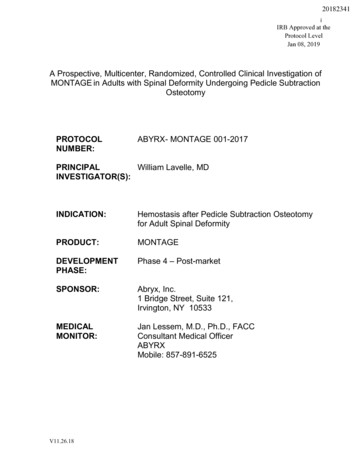
Transcription
20182341iIRB Approved at theProtocol LevelJan 08, 2019A Prospective, Multicenter, Randomized, Controlled Clinical Investigation ofMONTAGE in Adults with Spinal Deformity Undergoing Pedicle SubtractionOsteotomyPROTOCOLNUMBER:ABYRX- MONTAGE 001-2017PRINCIPALWilliam Lavelle, MDINVESTIGATOR(S):INDICATION:Hemostasis after Pedicle Subtraction Osteotomyfor Adult Spinal DeformityPRODUCT:MONTAGEDEVELOPMENTPHASE:Phase 4 – Post-marketSPONSOR:Abryx, Inc.1 Bridge Street, Suite 121,Irvington, NY 10533MEDICALMONITOR:Jan Lessem, M.D., Ph.D., FACCConsultant Medical OfficerABYRXMobile: 857-891-6525V11.26.18
iiTable of ContentsProtocol Approval . 7Investigator Agreement . 71.INTRODUCTION . 81.1STATEMENT OF INTENT . 81.2TITLE . 81.3BACKGROUND INFORMATION . 81.4OBJECTIVES . 92.1DESCRIPTION OF INVESTIGATIONAL PRODUCT UNDER TEST . 92.2PACKAGING AND LABELING . 102.3METHOD OF DISTRIBUTION . 102.4ACCOUNTABILITY . 10The investigator or designated individual will maintain inventories that will detail receipt, use,return and collection of Montage trial supplies by the company. The use inventory log will beused to document which products (batch, expiry, and quantity) were used on which subjects fortraceability. 103.TRIAL SUBJECT POPULATION . 103.1NUMBER OF SUBJECTS . 103.2SUBJECT SOURCES . 103.3SELECTION CRITERIA . 103.3.1Inclusion Criteria . 103.3.2Exclusion Criteria . 113.4WITHDRAWAL . 124.TRIAL DESIGN AND METHODOLOGY . 124.1TRIAL DESIGN . 124.2.1Screening and Pre-Treatment Regimen . 134.2.24.2.1.14.2.2.14.2.35.Visit #1: Screening Evaluation and Enrollment (Week -2) . 13Randomization . 14Visit #2: Randomization. Error! Bookmark not defined.Treatment . 144.2.3.1Visit #3: Treatment Phase (Week 0) . 144.2.3.2Visit #4: Follow-up Visit (Week 2) . 144.2.3.3 Visit #5: Follow-up Visit (Week 6) . 144.2.3.4 Visit #6: Follow-up Visit (Week 12) . 144.2.3.5Visit #7: Follow-up Visit (Week 24) . 144.2.3.6 Visit #8: Follow-up visit (Week 52) . 15ADVERSE EVENTS (DEFINITIONS AND REPORTING) . 155.1ADVERSE EVENT . 155.1.1Reporting of Adverse Events . 155.1.2Subject Follow-up . 165.2SERIOUS ADVERSE EVENT . 165.2.1Reporting Serious Adverse Events . 175.3UNANTICIPATED ADVERSE DEVICE EFFECT (UADE) . 175.3.1Reporting UADEs . 176.STATISTICAL DESIGN. 176.1DESIGN . 186.2SAMPLE SIZE . 186.3ANALYSIS PLAN . 186.3.1Subject Analysis Sets . 18V11.26.18
iii6.3.2Secondary Variables and Analyses . 196.3.3Safety . 196.3.4Other Data Summaries . 197.ADDITIONAL INFORMATION . 197.1USE OF ADDITIONAL MEDICAL SERVICES . 197.2SOURCE DATA VERIFICATION (SDV) . 197.3TRIAL MONITORING . 197.4USE OF TRIAL FINDINGS . 208.ETHICAL AND LEGAL ISSUES . 208.1GOOD CLINICAL PRACTICES (GCP) . 208.2APPROVAL OF PROTOCOL . 208.3CONFIDENTIALITY. 208.4INSURANCE/FINANCIAL. 208.5SUBJECT CONSENT . 209.REFERENCES . 22V11.26.18
ivList of aQoLSAESRS-22UADEVASV11.26.18Adverse EventCentimeterClinical Research AssociateCase Report FormU.S. Food & Drug AdministrationGood Clinical PracticeInternational Conference on HarmonizationIndependent Ethics CommitteeInchInstitutional Review BoardIntention-to-TreatOswestry Disability Index version 2.1aQuality-of-LifeSerious Adverse EventScoliosis Research Society -22 OutcomesUnexpected Adverse Device EffectVisual Analog Scale back and leg pain
5Title:SUMMARYA Prospective, Multicenter, Randomized, ControlledClinical Investigation of MONTAGE in Adults withSpinal Deformity undergoing Pedicle SubtractionOsteotomyShort Title:MONTAGE in PSO for Adult Spinal deformityProtocol Number:Montage 001-2017Phase:Phase 4-postmarketingMethodology:Prospective, randomized, open, controlled studyStudy Duration:2 years from entry of last subjectFollow-up:2 yearsStudy Centers:Multicenter study with up to 4-6 centersObjectives:Primary: To assess the safety and effectiveness ofMONTAGE in reducing post-operative blood lossSecondary: To assess the PSO stabilityNumber of Subjects:50 subjectsDiagnosis and Main Inclusion Criteria:1. Presence of spinal deformity requiring a PSO2. Patients aged 18-80 and3. Non-smokers (must have quit smoking 6 monthsprior to surgery) and current smokersStudy Product, Dose, Regimen:After surgically creating the wedged PSO defect, priorto closure of the osteotomy, patients will berandomized 1:1 to receive either MONTAGE applied tothe cut surfaces for the osteotomy site or no hemostaticmaterial.Duration of Administration:1 application during surgeryReference Therapy:Standard of care – no bone hemostat.V11.26.18
6End-points and Statistical Methodology:Efficacy Endpoint:The primary efficacy outcome variable for the study isthe amount of post-operative bleeding comparedbetween patients randomized 1:1 to MONTAGE orstandard of care (no bone hemostat). Blood loss willbe measured indirectly by formulae that provide anestimate through changes in hematocrit. A 2-sided “t”test will be used for the analysis.Safety Endpoints:Consistent with the standard of care, successfulreconstruction of the osteotomy site requiresobservation of the residual angle of the osteotomy andany gap that may be present. In order to demonstratethat the use of Montage does not negatively impact thedesired outcome, any residual gap will be measured inmillimeters and compared between the groups. Thiswill be done by including a CT scan performed at 1year post surger A 2-sided “t” test will be used for theanalysis.NRS back pain and NRS leg pain, SRS-22 andOswestry Disability Index (ODIv2.1a) will be comparedbetween the two groups and also reported assecondary outcome scores. Descriptive statistics willbe reported.V11.26.18
7PROTOCOL APPROVALDate ,,,,,,,,,,,,,,,,,,,,,,William Lavalle, MD.Date Jan Lessem, MD, Ph.DConsultant Medical OfficerABYRXINVESTIGATOR AGREEMENTThe signing of this protocol by the Investigator signifies that the contents have been laid down in fullagreement and that the trial will be conducted according Good Clinical Practice and to the proceduresdescribed.DateV11.26.18. Investigator
81.INTRODUCTION1.1STATEMENT OF INTENTThe design, conduct and reporting of this trial shall be undertaken in compliance with the protocol, ICH/GCPand all appropriate regulatory requirements.1.2TITLEA Prospective, Multicenter, Randomized, Controlled Clinical Investigation of MONTAGE in Adultswith Spinal Deformity undergoing Pedicle Subtraction Osteotomy1.3BACKGROUND INFORMATIONPEDICLE SUBTRACTION OSTEOTOMY - ASSOCIATED BLOOD LOSSPedicle Subtraction osteotomy (PSO) is a surgical option for treating several spinal deformities. It has beenutilized in alignment disorders of the fused spine, in the lumbar spine to treat large sagittal deformities andin patients with ankylosing spondylitis with thoracolumbar kyphotic deformity (1).PSO is a procedure most commonly performed in the lumbar and thoracic spinal regions. PSO is oftenavoided in the distal lumbar spine because the risk of the neurologic injury is greater and fewer fixationpoints are available. It has been suggested that some of the ideal candidates for PSO are those patientswith a substantial sagittal imbalance 10 to 12 cm, with a sharp angular kyphosis and patients who havecircumferential fusion along multiple segments. For most patients with ankylosing spondylitis, PSO couldbe the treatment of choice. The procedure involves surgical excision of a wedge of bone from the posteriorspine (osteotomy). The two cut edges are then drawn together by a system of screws and rods designedto apply compression and thus reduce the unnatural forward curvature of the spine.PSO typically results in substantial loss of blood (as much as 2L) with a significant portion of the loss likelyoccurring at the osteotomy surfaces post-surgically. Blood loss-associated morbidities can be direct,including hypotension, organ damage (particularly cardiac, pulmonary, renal) and coagulopathy. Excessiveblood loss also may require allogeneic blood transfusion, which may further result in acute lung injury,hypersensitivity reactions, infections, and immune suppression. Another concern with regard to postoperative bleeding in spinal surgery is the risk of spinal epidural hematoma formation, which might lead tospinal cord or cauda equina compression. Therefore, the control of peri-operative blood loss is considereda critical issue by spine surgeons (2,3,5).A variety of methods have been proposed for the reduction of blood loss during or immediately after spinesurgery, including preoperative use of erythropoietin, autologous blood, cell salvage, intra-operativecontrolled hypotension, and the use of anti-fibrinolytic drugs (6). Bone hemostats have traditionally notbeen part of the standard of care to promote hemostasis probably because most available options (e.g.,bone wax) are nonabsorbable and thus might interfere with fusion at the osteotomy site.MONTAGEMONTAGE is a settable (hardening) bioabsorbable polymer and hydroxyapatite/beta tricalcium phosphatebased putty, used in the control of bleeding from bone during spine, orthopedic, craniomaxillofacial, thoracicand other surgical procedures.It is easy to manipulate and typically results in immediate and complete cessation of bleeding at the bonydefect. The putty hardens within minutes after application, remaining secure in place, without beingdislodged or dissolved during the early stages of bone formation. In animal studies, the use of MONTAGEhas not been shown to interfere with bone healing or fusion (7).V11.26.18
9MONTAGE putty was implanted in rabbit diaphyseal femoral defects (N 12) and each defect was evaluatedafter 4 weeks by histopathology (8). The microscopic evaluation demonstrated no significant signs ofinflammation or fibrosis, while there was indication that new bone formation occurred. MONTAGE is fullyabsorbed within approximately 1 year and is replaced with endogenous bone.MONTAGE settable putty is FDA cleared as a bone hemostat in skeletal surgical procedures.1.4OBJECTIVESThe primary objective of this study is to evaluate the difference in postoperative bleeding between two studygroups, FDA cleared MONTAGE and standard of care (no bone hemostat), and the extent to which anytransfusion is needed and blood loss is measured through drop in hematocrit (HCT), as well as wound drainoutput, if utilized. As an exploratory evaluation of the primary endpoints a calculation will be made of bloodloss for the first 7 days following surgical procedure as assessed by a multivariate combination of thesemeasures of blood loss.The secondary objective is the stability of the construct, as measured by whether the correction hasmaintained stability at 1-year and 2-years post surgery. Each incidence of instability will be categorized asbelonging to one of the following groups: 1) hardware malplacement, 2) loosening or dislodegment, 3)nonunion or nonfusion with hardware fracture 4) nonunion or nonfusion without hardware fracture and 5)perihardware fracture.Each osteotomy site will be assessed using X-rays and with computed tomography (CT) scans – performedat 12 months post surgery. Failure of fusion will be determined to be present if an area of bone appositionlucency greater than 2mm in thickness is present.Secondary objectives will also include:- The formation of new bone, as measured by CT scans at 1-year post surgery,- Evaluation of Visual Analog Scale (VAS) back and leg pain, Oswestry Disability Index (ODIv2.1a), andSRS-22 scores, which will be recorded during the study and compared between the two groups.- Evaluation of work status.-Antifibrinolytics use and type will be recorded during the study and compared between the two groups2.INVESTIGATIONAL PRODUCT/TREATMENT2.1DESCRIPTION OF INVESTIGATIONAL PRODUCT UNDER TESTMONTAGE is a settable (hardening) bioabsorbable polymer and hydroxyapatite/beta tricalcium phosphatebased putty, used in the control of bleeding from bone during spine, orthopedic, craniomaxillofacial, thoracicand other surgical procedures, and has been FDA cleared.It is easy to manipulate and in all instances, as reported in preclinical studies, resulted in immediate andcomplete cessation of defect bleeding. The putty hardens within minutes after application, remaining securein place, without being dislodged or dissolved.In rabbit diaphyseal femoral defects (N 12), MONTAGE putty was implanted; and after 4 weeks each defectwas evaluated by histopathology. The microscopic evaluation demonstrated no significant signs ofinflammation or fibrosis, while there was indication that new bone formation occurred.V11.26.18
10MONTAGE has been used in many clinical settings, including during spinal and sternotomy procedures.Long-term follow-up in various settings has not demonstrated any adverse events of significance. (9, 10,11, 12).2.2PACKAGING AND LABELINGMONTAGE will be supplied terminally sterilized in individual packaged units of 5cc (10grams). MONTAGEshould be stored at room temperature.2.3METHOD OF DISTRIBUTIONDelivery of all study materials (e.g. product, CRFs, etc.) to the study centers will be arranged by theSponsor’s Clinical Research Associates (CRA).2.4ACCOUNTABILITYThe investigator or designated individual will maintain inventories that will detail receipt, use, return andcollection of Montage trial supplies by the company. The use inventory log will be used to documentwhich products (batch, expiry, and quantity) were used on which subjects for traceability.3.TRIAL SUBJECT POPULATION3.1NUMBER OF SUBJECTSA multicenter study will be undertaken in the US, with up to 4-6 centers contributing 50 patients (maximumof 20 patients per center). A sample size of 25 randomly assigned patients per study group (50 subjects intotal) was calculated to detect a clinically significant treatment effect of MONTAGE (90% power; alpha 0.05, 2-sided; 10% lost-to-follow up). This calculation was performed with the assumption that subjectswithin the control group lose on average 1,500 mL ( /- 500mL) of blood postoperatively while subjectswithin the treatment group will lose 1,000 mL of blood postoperatively.3.2SUBJECT SOURCESAdult subjects referred to hospital or community-based clinics for treatment of spinal deformity will beeligible for the study.3.3SELECTION CRITERIAThe following criteria must be met before a subject is recruited to the trial:3.3.1Inclusion Criteria1.Subject is at least 18 years old, and not more than 80 years old.2.Presence of spinal deformity requiring a PSO at a single site level, such as for patients withthoracolumbar kyphotic deformity, sagittal imbalance, and spinal global malalignment.3.Non-smokers (have proven to quit smoking for at least 6 months prior to surgery) and currentsmokersV11.26.18
113.Female subjects of childbearing potential must be willing to use acceptable methods ofcontraception (birth control pills, barriers, or abstinence). A pregnancy test at the Week 0 visit mustbe administered, and must be negative, for inclusion into the study.4.Subject understands and is willing to participate in the clinical study and can comply with requiredvisits and the follow-up regimen.5.Subject has read and signed the Institutional Review Board (IRB)/Independent Ethics Committee(IEC) approved Informed Consent Form before screening procedures are undertaken.3.3.2Exclusion Criteria1.Subjects whose spinal deformity is deemed by the investigator to be of such severity that a possiblesurgical intervention would be either harmful or not warranted.2.Subjects with morbid obesity (i.e. a Body Mass Index [BMI] 40).3.Subjects who have a known allergy to the components of MONTAGE.4.Subjects who are non-mobile (i.e. not ambulatory, or have significant impairment of their mobilitymaking them completely bedridden).5.Subjects who, in the opinion of the investigator, show evidence of infection, cellulitis, and/orosteomyelitis.6.Subjects with abnormally low platelets, abnormal coagulation parameters, or with documentedbleeding disorders, including a prior history of excessive bleeding during surgery.6.Subjects with a history of a malignancy, not in remission for five years or more, or a newlydiagnosed malignancy, treated with cytotoxic therapies or radiation therapy.7.Subjects on any investigational drug(s) within 30 days preceding randomization (i.e. Week 0); orsubject or physician anticipates use of any of these therapies by the subject during the course ofthe study.8.Subjects with:(ii)Alcohol abuse as recorded by an average daily intake of 4 units in females, 5 units inmales (i.e. 1 oz. of spirit, glass of wine, or can of beer per unit).(iii)Drug abuse as evidenced by the subject’s use of illegal drugs or prescription drugs thathave not been prescribed for him/her.9.Subjects with one or more medical conditions, as determined by medical history, including renal,hepatic, hematologic, active auto-immune or immune diseases that, in the opinion of theInvestigator, would make the subject an inappropriate candidate for this study.10.Subjects with a history of osteoporosis, as defined by imaging, or on medication for osteoporosisor documented fracture of fragility (Hip fracture, osteoporotic compression fracture, distal radiusfracture). If there are any concerns these may be arbitrated by the study PI.11.Subject has previously participated in any MONTAGE trial.12.Subjects who are unable to understand the aims and objectives of the trial and/or unwilling to returnfor the follow-up examinations.V11.26.18
123.4WITHDRAWALSubjects may drop out or be withdrawn at their own request. Although subjects need not give a reason forrequesting withdrawal from the trial, the investigator should make a reasonable effort to ascertain thereason(s), while fully respecting the subject's rights.4.TRIAL DESIGN AND METHODOLOGY4.1TRIAL DESIGNThis study will be an open, prospective, multicenter, randomized, and controlled study to evaluate theeffects of MONTAGE on blood loss and maintenance of the PSO corrective surgical procedure.Patients will be randomized to receive either standard of care (no bone hemostat) or MONTAGE. Withineach study group, patients will be stratified according to their smoking status (non-smokers versus currentsmokers).4.1.1 PRIMARY OBJECTIVETo assess the effectiveness of MONTAGE in reducing blood loss in the first week after surgery. A formulawill be used to calculate blood loss during the post-surgical period up until day 7 or hospital discharge(whichever comes first). The following formula from the Harms Study Group, shown at day 3 as an example,will be used and comparisons of blood loss between the two groups will be calculated.4.1.2 SAFETY OBJECTIVESSafety objectives will include:- Evaluation of the repaired osteotomy by measuring displacement of the edges of the bone undercompression. The angular measurement is the angle between the superior endplate of the vertebral bodybelow the PSO and the inferior endplate of the vertebral body above the PSO. Consistent with thestandard of care, successful reconstruction of the osteotomy site requires observation of the residualV11.26.18
13angle of the osteotomy and any gap that may be present. In order to demonstrate that the use ofMontage does not negatively impact the desired outcome, any residual gap will be measured inmillimeters and compared between the groups. This will be done by including a CT scan performed at 1year post surger A 2-sided “t” test will be used for the analysis.- To demonstrate that Montage does not interfere with the repair, evaluation of the formation of new bone,as measured by CT scans at 1-year post surgery.- Evaluation using the VAS back pain and leg pain, Oswestry Disability Index (ODIv2.1a) and SRS-22,which will be recorded during the study and reported as outcomes scores, and compared between the twogroups.-Antifibrinolytics use and type will be recorded during the study and compared between the two groups4.2 TREATMENT METHODOLOGYMONTAGE will be used only at a focal site where the osteotomy is performed. It will be applied to the edgesof the spine defect after removal of the wedge. MONTAGE will be applied immediately prior to placing theosteotomy site under compression prior to its hardening so as to ensure no interference with compressionagainst the osteotomy edges. Participating investigators, at their discretion, may use autograft and allograftbone void fillers for the other parts of the spine fusion as part of standard of care.A teaching video will be used to ensure strict adherence to the study procedure at all sites.Hematological parameters, such as Hb, Hematocrit, RBC, WBC, platelet counts, MCV, MCHC, anddifferential counts will be recorded and compared between the groups at baseline, immediate post-surgery,and daily up until day 7 or discharge (whichever comes first).All standard-of-care blood values, including CBC, electrolytes, liver function and kidney function tests duringthe initial hospital admission will be recorded and analyzed at certified laboratories.Consistent radiographic parameters will be used to evaluate the angular measurements between thesuperior endplate of the vertebral body below the PSO and the one above it.All radiographic images will be read by two reviewers, without knowledge of treatment groups (i.e., blinded).The radiographic techniques that will be employed in this study are X-rays and CT scans of thethoracolumbar spine without contrast, focusing on the vertebral segments above the osteotomy, theosteotomy segment itself, and the spinal area just below the osteotomy procedure. All images during thestudy will be read by the same two reviewers.4.2.1Screening and Pre-Treatment Regimen4.2.1.1 Visit #1: Screening Evaluation and Enrollment (Week -2) Signed written Informed Consent Form will be obtained.Subjects will be enrolled according to the Inclusion and Exclusion criteria listed above.Subject demographics, medical history, and vital signs will be recorded.A blood sample will be drawn from the subject for analysis of hematological and biochemicalparameters at a central laboratory consistent with the study institutions preoperative workup Subjects will undergo pre-operative imaging using CT and radiographs, which are based onstandard of care. Patient’s co-morbidities will be scored using the Charlson Comorbidity index, the ASA score as wellas ISSG severity scores.V11.26.18
14 4.2.2A list of pain medications with dosing will be recordedVAS back and leg pain, ODIv2.1a and SRS-22 scores will be collected as a baseline.RandomizationThe randomization will occur with the participating center contacting the central study datarepository after submitting preoperative subject data; random assignment will be generated bycomputer. Patients will be randomized to either PSO with MONTAGE or standard of care4.2.3Treatment4.2.3.1 Visit #2: Treatment Phase (Week 0)The patient will undergo the surgical intervention, excising a bone wedge from the vertebral bodyfollowed by a closure of the defect and re-apposition of the bony edges, creating the correction.Just prior to closure of the osteotomy, either MONTAGE or no bone hemostat will be placed onthe surface of the cut bone.Operative parameters, including surgery time (duration of surgery) level of the osteotomy andtype of surgery, as well as intra-operative blood loss will be recorded.The use of anti-fibrinolytics will be recorded.Regular blood values, including Hb, Hematocrit, RBC, WBC, platelet count, MCV, MCHC anddifferential counts will be performed on each
V11.26.18 8 1. IN97OD:C9ION 1.1 STATEMENT OF INTENT The design, conduct and reporting of this trial shall be undertaken in compliance with the protocol, ICH/GCP

